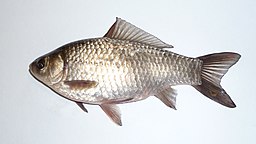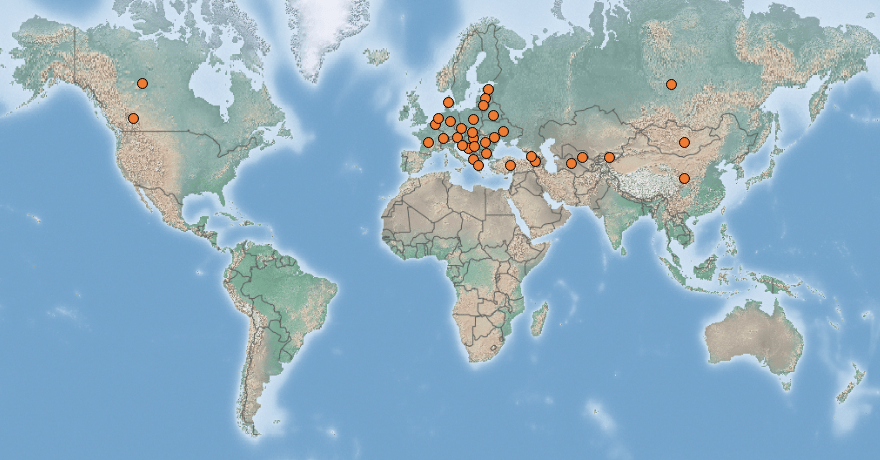 |
Prussian carp | Status LU: established. 1st record: ~1825 |
 |
Grousse koppesche Kaarp1 | Status Eur.: established. |
 |
Carassin argenté | RA: ISEIA: C1. Harmonia+: n/a. |
 |
Giebel | Wikipedia:     | Wikispecies: | Wikispecies:  | CABI | CABI |
 |
Giebel | Back to the list of vertebrates |
Contents
Report the species
→ Report Carassius gibelio to the National Museum of Natural History.
Brief description
 Carassius gibelio (Bloch, 1782) has potential to cause economic and environmental damage by causing quantitative changes in community structure in becoming the dominant species and shifts in food chains, and by altering the physical and chemical properties of habitats. A major biological trait responsible for invasiveness in C. gibelio is its mode of reproduction. Invading populations are often triploid and composed of almost exclusively females that exhibit apomictic (gynogenetic) reproduction, using the sperm of other species to activate (but not fertilize) their own eggs. C. gibelio have been introduced intentionally for the purposes of food production and unintentionally due to the similarity in appearance between C. gibelio and native Carassius spp. (CABI, 2019).
Carassius gibelio (Bloch, 1782) has potential to cause economic and environmental damage by causing quantitative changes in community structure in becoming the dominant species and shifts in food chains, and by altering the physical and chemical properties of habitats. A major biological trait responsible for invasiveness in C. gibelio is its mode of reproduction. Invading populations are often triploid and composed of almost exclusively females that exhibit apomictic (gynogenetic) reproduction, using the sperm of other species to activate (but not fertilize) their own eggs. C. gibelio have been introduced intentionally for the purposes of food production and unintentionally due to the similarity in appearance between C. gibelio and native Carassius spp. (CABI, 2019).
Status and distribution in Luxembourg
Records of Carassius gibelio Bloch, 1782 in Luxembourg. Data source: Recorder-Lux, iNaturalist & GBIF, 2024-07-27.
Carassius gibelio (Bloch, 1782) was probably introduced in Luxembourg in the period 1820 – 1830 (De La Fontaine 1872). During river inventories in 2005, 392 individuals were caught in the rivers Alzette, Lower Sauer and Moselle, which was three times as many as were caught during a similar survey in 1996/1997 but with catches occurring in fewer rivers (Administration de la gestion de l’eau 2010).
The Prussian carp is a thermophilic fish species living in eutrophic still and slow-running waters, often with submerged aquatic vegetation. It is a prolific species which is believed to be responsible for the decline of native fish, invertebrate and plant populations in different areas. Furthermore, it is notorious for increasing water turbidity because of its habit of stirring up bottom sediments during feeding.
Risk assessment
ISEIA protocol
C1 (2+2+1+1) (Ries et al. 2014: 199).
Harmonia+ protocol
Not assessed yet.
Worldwide distribution
Bibliography
- Administration de la gestion de l’eau, 2010. Les poissons au Luxembourg, Cartographie des poissons, lamproies et écrevisses du grand-duché de Luxembourg, 213 pp.
- CABI, 2019. Carassius gibelio (Bloch, 1782). In: Invasive Species Compendium. Wallingford, UK: CAB International. URL: www.cabi.org/isc [accessed 2020-04-22]
- De la Fontaine, A. (1872): Faune du Pays du Luxembourg. – Poissons Publ. Inst. Roy. Gr.-D. Luxb. 8: 1-88.
- Klees, H., 1981. Luxemburger Tiernamen. Beiträge zur luxemburgischen Sprach- und Volkskunde XIV. Institut grand-ducal, Section de linguistique, de folklore et de toponymie. 2. Aufl. 131 S. Imprimerie Pierre Linden, Luxembourg.
- MNHNL, iNaturalist & GBIF, 2020. Carassius gibelio (Bloch, 1782) in MNHNL-mdata, online portal combining species observation from Recorder-Lux, iNaturalist and GBIF. National Museum of Natural History, Luxembourg. URL: https://mdata.mnhn.lu [accessed 2020-04-22]
- Ries, C., M. Pfeiffenschneider, Engel, E., J.-C. Heidt & M. Lauff, 2014. Environmental impact assessment and black, watch and alert list classification after the ISEIA Protocol of vertebrates in Luxembourg. Bull. Soc. Nat. luxemb. 115: 195-201. [PDF 247 KB]
Suggested citation of this webpage
Ries, C. & M. Pfeiffenschneider (Eds.), 2024. Carassius gibelio (Bloch, 1782). In: neobiota.lu - Invasive Alien Species in Luxembourg. National Museum of Natural History, Luxembourg. URL: https://neobiota.lu/carassius-gibelio/ [Accessed 2024-07-27].
Page content last updated on 2020-04-28.
- Cf. Klees 1981: 26.[↩]


